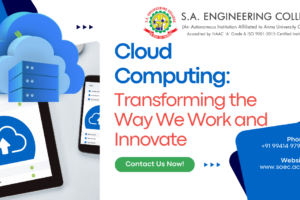
Know About The Cloud Computing: A Comprehensive Guide
- Posted by Praveenkumar S
- Categories Cloud Computing
- Date March 15, 2025
Introduction: What Is Cloud Computing?
Imagine accessing your files, running applications, or leveraging powerful computing resources anytime, anywhere, without being tied to a physical device. That’s the essence of cloud computing. At its core, cloud computing refers to the delivery of IT services such as storage, servers, databases, networking, software, and more via the internet. Instead of relying on local hardware, users tap into shared resources hosted on remote servers, collectively known as “the cloud.”
Cloud computing has not only revolutionized personal computing but also disrupted industries by enabling businesses to reduce costs, improve efficiency, and innovate faster. It’s the engine powering our digital economy, from streaming platforms like Netflix to collaborative tools like Google Workspace.
Why Cloud Computing Matters
Cloud computing isn’t just a buzzword; it’s a technological shift that’s changing how we live, work, and interact. Here’s why it’s so critical:
- Cost Savings
Traditional IT setups involve high capital expenses for hardware and ongoing operational costs for maintenance. Cloud computing replaces these with a flexible pay-as-you-go model, significantly lowering upfront investment.
- Scalability
Whether you’re a small startup or a multinational corporation, the cloud scales with your needs. It allows businesses to add or reduce resources based on demand, ensuring optimal resource utilization.
- Innovation Enabler
Cloud services provide tools and frameworks that spur innovation. Developers can build, test, and deploy applications quickly without worrying about managing infrastructure.
- Global Accessibility
With cloud services, employees and teams can collaborate seamlessly, no matter where they are located. It also ensures data consistency across devices and geographies.
Cloud Computing Models Explained
Understanding the various service models of cloud computing is crucial for determining what suits your needs. These models are often referred to as the “stack” of cloud services.
- Infrastructure as a Service (IaaS)
IaaS is the foundational layer of cloud computing, offering virtualized computing resources over the internet. It provides the infrastructure needed to run applications, including servers, storage, and networking.
Who Uses It?
Businesses that need scalability, disaster recovery, or to host complex applications.
Examples:
- Amazon Web Services (AWS)
- Microsoft Azure
- Platform as a Service (PaaS)
PaaS offers a platform where developers can build, test, and deploy applications without dealing with the complexities of managing underlying hardware and software.
Who Uses It?
Development teams focusing on software creation and innovation.
Examples:
- Google App Engine
- Microsoft Azure App Services
- Software as a Service (SaaS)
SaaS delivers fully functional software applications over the internet. Users access these tools via a web browser without worrying about installation, maintenance, or updates.
Who Uses It?
End-users who need ready-to-use applications for everyday tasks.
Examples:
- Salesforce for CRM
- Dropbox for cloud storage
Cloud Deployment Models
Choosing the right deployment model is essential for balancing control, security, and flexibility.
- Public Cloud
In a public cloud, resources like storage and servers are shared among multiple users and accessed over the internet. It’s cost-effective and ideal for startups and SMEs.
Advantages:
- Low initial cost
- No maintenance overhead
Examples:
- AWS
- Google Cloud
- Private Cloud
A private cloud is dedicated to a single organization, providing enhanced security and control. It’s often hosted on-premises or by a third-party provider.
Advantages:
- High security
- Customizable to organizational needs
Use Cases:
- Financial institutions
- Government agencies
- Hybrid Cloud
A hybrid cloud combines public and private clouds, enabling businesses to manage sensitive data on private servers while using public resources for non-critical tasks.
Advantages:
- Flexibility and scalability
- Optimized cost and resource management
Examples:
- IBM Hybrid Cloud
The Benefits of Cloud Computing
The widespread adoption of cloud computing isn’t without reason. Its benefits touch every aspect of modern technology and business operations.
- Cost Efficiency
The cloud eliminates the need for capital expenditures on physical infrastructure. Businesses only pay for what they use, transforming fixed costs into operational expenses.
- Scalability
The ability to scale resources up or down based on demand ensures businesses can handle traffic spikes without over-investing in unused capacity.
- Collaboration and Accessibility
With cloud services, teams can work together in real-time, access data from anywhere, and ensure data consistency across locations.
- Enhanced Security
Leading cloud providers offer state-of-the-art security features, such as encryption, multi-factor authentication, and compliance with international standards.
- Business Continuity
Cloud services simplify data backup and disaster recovery, ensuring minimal disruption during unexpected events like cyberattacks or natural disasters.
Industries Revolutionized by Cloud Computing
- Healthcare
Cloud computing enhances patient care by enabling secure storage and sharing of medical records, facilitating telemedicine, and improving access to advanced analytics for diagnostics.
- Education
Cloud-based learning management systems (LMS) and virtual classrooms have made education more accessible and interactive, particularly during the pandemic.
- Retail
From inventory management to customer analytics, cloud solutions empower retailers to optimize operations and provide personalized shopping experiences.
- Entertainment
Streaming giants like Netflix use the cloud for efficient content delivery, data analytics, and recommendation engines.
Challenges in Cloud Computing
- Data Security and Privacy Entrusting sensitive data to third-party providers raises concerns about breaches and compliance.
- Downtime and Internet Dependency Dependence on stable internet connections can lead to disruptions during outages.
- Vendor Lock-In Transitioning between cloud providers can be complex and costly due to proprietary tools and data compatibility issues.
Emerging Trends in Cloud Computing
- Edge Computing
By processing data closer to the source, edge computing reduces latency and improves real-time decision-making, especially for IoT devices.
- Serverless Computing
This model allows developers to focus solely on writing code while the cloud provider manages infrastructure.
- Multi-Cloud Strategies
Businesses are increasingly using multiple cloud providers to avoid vendor lock-in and improve resilience.
- AI and Machine Learning Integration
Cloud platforms are democratizing AI by providing tools and frameworks that enable businesses of all sizes to leverage machine learning.
Future of Cloud Computing
The future of cloud computing lies in its seamless integration with emerging technologies like quantum computing and blockchain. With advancements in security, cost management, and performance optimization, the cloud will continue to shape our digital landscape.
Conclusion
Cloud computing is the lifeblood of modern technology, enabling innovation, efficiency, and global collaboration. As businesses and individuals continue to adopt cloud-based solutions, it’s clear that the cloud is not just a trend but a transformative force.
Ready to embrace the cloud? The possibilities are endless!
You may also like



